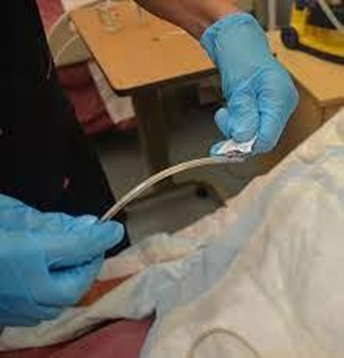A nurse is caring for a client who is postoperative following a bowel surgery and has an NG tube connected to low intermittent suction. Which of the following assessment findings should indicate to the nurse that the NG tube might not be functioning properly?
Wall suction set to 60 mm Hg
Drainage fluid is greenish-yellow
Aspirate pH of 3
Abdominal rigidity
The Correct Answer is B
A. The wall suction setting does not directly indicate the functioning of the NG tube.
B. Greenish-yellow drainage fluid may indicate the presence of bile in the stomach, suggesting
that the NG tube is not adequately draining gastric contents, which could indicate a malfunction.
C. An aspirate pH of 3 indicates gastric acidity, which is expected in the stomach and does not necessarily indicate a problem with NG tube function.
D. Abdominal rigidity may suggest intra-abdominal pathology but does not specifically indicate NG tube dysfunction.

Nursing Test Bank
Naxlex Comprehensive Predictor Exams
Related Questions
Correct Answer is C
Explanation
A. Encouraging the client to gain 2.3 kg (5 lb) per week may be excessive and unrealistic, potentially contributing to feelings of failure and exacerbating the client's condition.
B. Weighing the client once per week throughout hospitalization is important for monitoring weight changes, but it does not specifically address the immediate post-meal monitoring needed to prevent complications such as purging.
C. Monitoring the client for 1 hr after meals helps prevent behaviors such as purging or other forms of compensatory behaviors that may occur immediately after eating.
D. Allowing the client to choose meal times may not be appropriate as it can perpetuate disordered eating patterns. Establishing regular meal times is important for promoting consistent eating habits.
Correct Answer is D
Explanation
A. Brushing teeth immediately after eating may exacerbate nausea in some individuals. It is recommended to wait a while after eating before brushing teeth, or rinse the mouth with water.
B. Lying down after meals can worsen symptoms of nausea and reflux. Remaining upright or sitting up after meals may help alleviate symptoms.
C. Drinking large amounts of water with meals may exacerbate feelings of fullness and contribute to nausea. Sipping small amounts of fluids between meals is recommended.
D. Eating a dry carbohydrate, such as crackers or toast, before getting out of bed can help alleviate morning sickness by stabilizing blood sugar levels and absorbing stomach acid.
Whether you are a student looking to ace your exams or a practicing nurse seeking to enhance your expertise , our nursing education contents will empower you with the confidence and competence to make a difference in the lives of patients and become a respected leader in the healthcare field.
Visit Naxlex, invest in your future and unlock endless possibilities with our unparalleled nursing education contents today
Report Wrong Answer on the Current Question
Do you disagree with the answer? If yes, what is your expected answer? Explain.
Kindly be descriptive with the issue you are facing.
